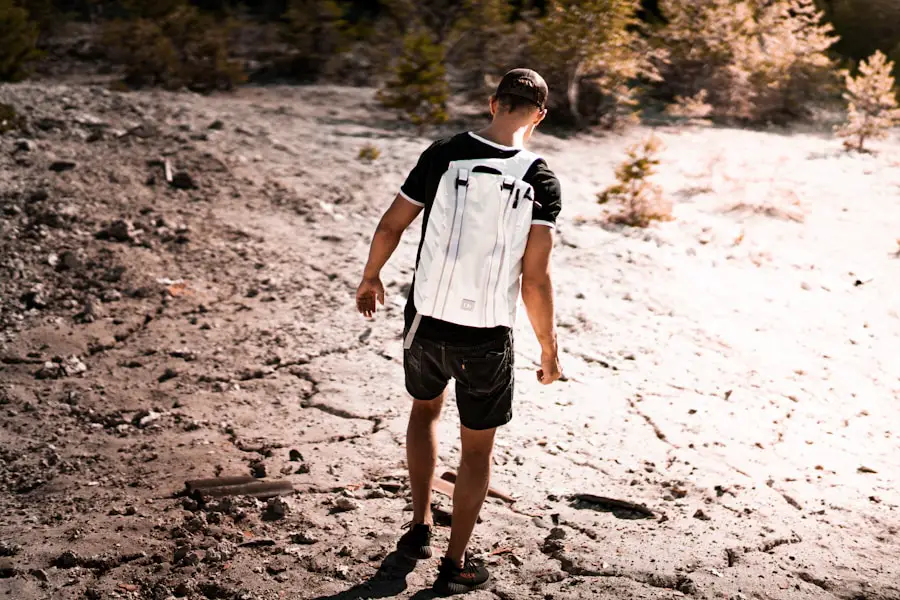When embarking on a hiking adventure in hot weather, the significance of appropriate clothing cannot be overstated. The right attire not only enhances comfort but also plays a crucial role in ensuring safety during outdoor activities. In high temperatures, the body is at risk of overheating, which can lead to heat exhaustion or heat stroke.
Wearing suitable clothing helps regulate body temperature, allowing hikers to enjoy their experience without the debilitating effects of excessive heat. Moreover, proper clothing can protect against environmental factors such as sun exposure, insects, and abrasions from vegetation. In addition to safety and comfort, the right clothing can significantly impact performance.
Lightweight and breathable fabrics allow for better movement and flexibility, which is essential when navigating uneven terrain. Clothing designed specifically for hiking often incorporates features that enhance functionality, such as pockets for storage and ventilation systems that promote airflow. By investing in proper clothing, hikers can focus on the beauty of their surroundings rather than the discomfort of their attire, leading to a more enjoyable and fulfilling outdoor experience.
Key Takeaways
- Proper clothing is essential for hot weather hiking to prevent heat-related illnesses and discomfort.
- Choose lightweight, moisture-wicking fabrics like nylon and polyester for hot weather hiking to stay cool and dry.
- Look for clothing with features such as ventilation, UPF protection, and adjustable options for hot weather hiking.
- Layering with breathable and sun-protective clothing is key for hot weather hiking to regulate body temperature.
- Opt for breathable, quick-drying, and supportive footwear for hot weather hiking to prevent blisters and discomfort.
Choosing the Right Fabrics for Hot Weather Hiking
Selecting the appropriate fabrics is a fundamental aspect of preparing for hot weather hiking. Natural fibers like cotton may seem appealing due to their softness and comfort; however, they tend to retain moisture, which can lead to chafing and discomfort during strenuous activities. Instead, synthetic materials such as polyester and nylon are often recommended for their moisture-wicking properties.
These fabrics draw sweat away from the skin, allowing it to evaporate quickly and keeping the body cooler. In addition to moisture management, the breathability of the fabric is crucial. Fabrics with a tight weave can trap heat and moisture, while those with a looser weave allow for better airflow.
For instance, mesh panels incorporated into shirts or shorts can enhance ventilation, making a significant difference in comfort levels during long hikes. Furthermore, some advanced fabrics are engineered with cooling technologies that actively lower skin temperature when wet, providing an extra layer of comfort in extreme heat.
Features to Look for in Hot Weather Hiking Clothing

When selecting clothing for hot weather hiking, certain features can greatly enhance the overall experience. One of the most important aspects is ventilation. Look for garments with strategically placed vents or mesh panels that promote airflow.
This feature is particularly beneficial in shirts and pants, where heat tends to accumulate. Additionally, clothing with adjustable openings can help regulate temperature based on changing conditions throughout the day. Another critical feature is moisture-wicking capability.
As mentioned earlier, fabrics that effectively pull sweat away from the skin are essential for maintaining comfort during hikes. Some brands offer clothing treated with antimicrobial properties to reduce odor buildup, which can be particularly advantageous on multi-day hikes where laundry facilities are unavailable. Furthermore, consider clothing with built-in UV protection; many outdoor brands now offer garments with UPF (Ultraviolet Protection Factor) ratings that shield the skin from harmful sun rays.
Layering for Hot Weather Hiking
| Layering Level | Temperature Range (Fahrenheit) | Recommended Clothing |
|---|---|---|
| Base Layer | Above 80°F | Moisture-wicking t-shirt and shorts |
| Mid Layer | 70-80°F | Lightweight long-sleeve shirt or sun hoodie |
| Outer Layer | 60-70°F | Lightweight windbreaker or sun jacket |
| Additional Protection | Above 80°F | Wide-brimmed hat, sunglasses, and sunscreen |
Layering may seem counterintuitive when preparing for hot weather hikes; however, it can be an effective strategy for managing temperature fluctuations throughout the day. Early morning hikes may start off cool, necessitating a light base layer that can be easily removed as temperatures rise. A breathable long-sleeve shirt made from moisture-wicking fabric can provide initial warmth while also offering sun protection.
As the day progresses and temperatures increase, hikers can transition to lighter layers or even short sleeves. The key is to choose layers that are easy to pack and lightweight so they do not add unnecessary bulk to your gear. A lightweight windbreaker or a packable jacket can be beneficial for unexpected weather changes without causing overheating.
The ability to adapt to varying conditions while maintaining comfort is a hallmark of effective layering strategies in hot weather hiking.
Footwear for Hot Weather Hiking
Footwear is another critical component of hot weather hiking gear that warrants careful consideration. The right shoes can make or break a hiking experience, especially in warm conditions where feet are prone to swelling and discomfort. Breathable hiking shoes or sandals designed specifically for hot weather are ideal choices as they allow air circulation while providing adequate support.
When selecting footwear, look for options with moisture-wicking insoles that help keep feet dry and comfortable. Additionally, shoes with a lightweight design reduce fatigue during long hikes. Traction is also essential; consider shoes with rubber outsoles that provide grip on various terrains while ensuring stability on rocky or uneven surfaces.
For those who prefer sandals, models with adjustable straps can offer a customizable fit while still allowing for breathability.
Accessories for Hot Weather Hiking

Accessories play a vital role in enhancing comfort and safety during hot weather hikes. A wide-brimmed hat is an essential item that provides shade and protects the face and neck from direct sunlight. Look for hats made from lightweight materials with moisture-wicking properties to keep sweat at bay while ensuring breathability.
Sunglasses are another crucial accessory that should not be overlooked. Opt for polarized lenses that reduce glare and provide UV protection for the eyes. This is particularly important when hiking near water bodies or in open areas where sunlight reflects off surfaces.
Additionally, consider using a lightweight neck gaiter or bandana that can be soaked in water and worn around the neck or head to provide cooling relief as temperatures rise.
Sun Protection for Hot Weather Hiking
Sun protection is paramount when hiking in hot weather, as prolonged exposure to UV rays can lead to serious health issues such as sunburn and skin cancer. In addition to wearing protective clothing and accessories, applying sunscreen is essential. Choose a broad-spectrum sunscreen with an SPF of at least 30 and ensure it is water-resistant for extended wear during physical activities.
Reapplication of sunscreen every two hours is crucial, especially after sweating or swimming. Pay special attention to commonly overlooked areas such as the ears, back of the neck, and tops of the feet. For those who prefer a more natural approach, consider using mineral-based sunscreens that contain zinc oxide or titanium dioxide as they provide effective protection without harsh chemicals.
Tips for Staying Cool and Comfortable on Hot Weather Hikes
Staying cool and comfortable during hot weather hikes requires proactive strategies beyond just clothing choices. Hydration is one of the most critical factors; hikers should aim to drink water regularly throughout their journey rather than waiting until they feel thirsty. Carrying a hydration pack or water bottles that are easily accessible encourages consistent fluid intake.
Timing your hike can also make a significant difference in comfort levels. Early morning or late afternoon hikes typically offer cooler temperatures compared to midday excursions when the sun is at its peak intensity. If possible, plan routes that provide shade from trees or other natural features to minimize direct sun exposure.
Additionally, taking regular breaks in shaded areas allows the body to cool down and recover before continuing on the trail. Incorporating these strategies into your hot weather hiking preparation will not only enhance your comfort but also ensure a safer and more enjoyable outdoor experience. By prioritizing proper clothing choices, understanding fabric properties, and utilizing effective accessories and sun protection measures, hikers can fully embrace the beauty of nature without succumbing to the challenges posed by high temperatures.
If you’re looking for the perfect gift for a female traveler, check out this article on the best travel gifts for women. It offers a variety of thoughtful and practical ideas that any woman who loves to explore the world would appreciate. And if you’re planning a hiking trip in hot weather, make sure to read our guide on what to wear to stay cool and comfortable on the trail. Additionally, if you’re in need of new luggage for your upcoming adventures, take a look at our list of must-have hardside carry-on luggage with spinner wheels for Spring 2025 to find the perfect travel companion.
Love travel? Join Our Facebook Community For More Tips.
FAQs
What should I wear for hiking in hot weather?
For hiking in hot weather, it’s important to wear lightweight, breathable clothing that wicks away moisture. Choose moisture-wicking shirts, shorts, and pants made of synthetic materials like polyester or nylon.
What type of footwear is best for hiking in hot weather?
Opt for lightweight, breathable hiking shoes or trail running shoes with good ventilation. Look for shoes with mesh uppers and a supportive sole for comfort and stability on the trail.
Should I wear a hat while hiking in hot weather?
Yes, wearing a hat with a wide brim or a cap with a neck flap can provide shade and protect your face and neck from the sun. Look for hats made of breathable, quick-drying materials.
What accessories should I consider for hiking in hot weather?
Consider wearing sunglasses with UV protection to shield your eyes from the sun’s glare. Additionally, wearing a lightweight, breathable neck gaiter or bandana can help protect your neck from sunburn.
Are there any specific clothing items to avoid for hiking in hot weather?
Avoid wearing cotton clothing, as it tends to retain moisture and can lead to discomfort and chafing. Instead, opt for moisture-wicking, quick-drying synthetic materials for your hiking attire.
